By Alex Wilson and Hope Yu

Introduction
For our sixth lab of the term, we constructed a funeral pyre to test medieval practices of cremation while also firing our early medieval English clay pots from lab three. This lab tended toward the experimental as much of Professor Austin’s research revolves around Anglo-Saxon medieval cremation and inhumation methods. Moreover, recent theories have posed the possibility of firing urns during cremation. Therefore, this lab attempted to integrate these two transformative processes into a singular event on Mai Fête island on a drizzly May day.
Excavations from Northern European archaeological sites display the complicated process of a cremation ritual. This event would have included numerous steps, such as the washing of the body, the weeping, and the collection of wood, that walked the line between cultural and technological. This further emphasizes the need for experiential and experimental tests such that academics can come to a more holistic understanding of these cultural phenomenons. Literary works, such as Beowulf, can also provide evidence for the chaine operatoire of the Anglo-Saxon cremation process.
We established three tiers of analysis previous to the lab. Isolating the cremation component, we hypothesized that the most representative scenario of Medieval English funeral pyres was the combination of a low platform and taller, encompassing structure where the platform is first built, the body is laid out, then more wood is piled on top and around before being lit. With regard to the pottery firing, we proposed that if cremation urns were custom made for the event, they could have been fired on the same pyre as the body. Lastly, our overall conjecture was that a lifetime of experience in building and maintaining a hot fire to transform wet clay into hardened ceramic ware would have influenced practices of fire construction, temperature maintenance and retrieval of bone from the ashes in the cremation rite, and vice versa.
Methods

Our lab began with the collection of dry and (disappointingly) wet timber from near the Arboretum Office, and the transport of this wood to Mai Fête, where our lab would take place. After splitting the wood into smaller portions, we split into our groups to accomplish our tasks for the day.
The materials we began the lab with included a thermocouple, blue laser thermometer, yellow laser thermometer, digital scale, rulers, calipers, timing device, axe/hatchet wood splitter, matches, wood / tinder, fatwood, your own bone dry pots, lamb (body stand in), clothes (dyed cloth), brooch (pin to secure clothes), and water. For the pottery, we intended to record the pot temperature throughout the process, the final statistics for your pot after firing on pottery lab sheet: weight, height, diameter (rim & widest), wall section, the general shape and structure of bonfire, changes in pot positioning during the fire, and the duration of pot firing. For the cremation, we looked to include the temperature of lamb shoulder throughout process, the weight of body before firing and remains afterwords, color of cremated bone after firing, shape and structure of pyre, and the duration of cremation.
Four groups, A, B, E, and F were tasked with heating their pots in small above-ground fire pits. These groups started by lighting their fires and burning them down to embers. Then they placed their room temperature unfired pots in the above-ground fire pits to warm them up slowly, avoiding thermal shock, which could have caused the pots to explode or spall. All six groups put their pots in these fires while the cremation pyre, which would burn at a much higher temperature, was built. Once the pots were about 230 degrees celsius, the cremation pyre groups removed their pots from the above-ground fire pits. Groups A, B, E, and F moved quickly to start the process of lighting a new vertical fire. We moved the pots from their position around the circumference of the small fire pit to the center, stacking them with the largest in the middle. The structure of the new fire was made by placing the wood vertically around the central pot stack. While most people’s attention shifted to watching the main funeral pyre, some people within each group had to tend to the smaller fires. Small teepee fires were built over the pots, which were pulled on top of the embers in the centers of the small above-ground pits. These were lit and reached about 800 degrees celsius, the temperature needed for clay to transform into ceramic, before reducing to ash and embers around the pots.
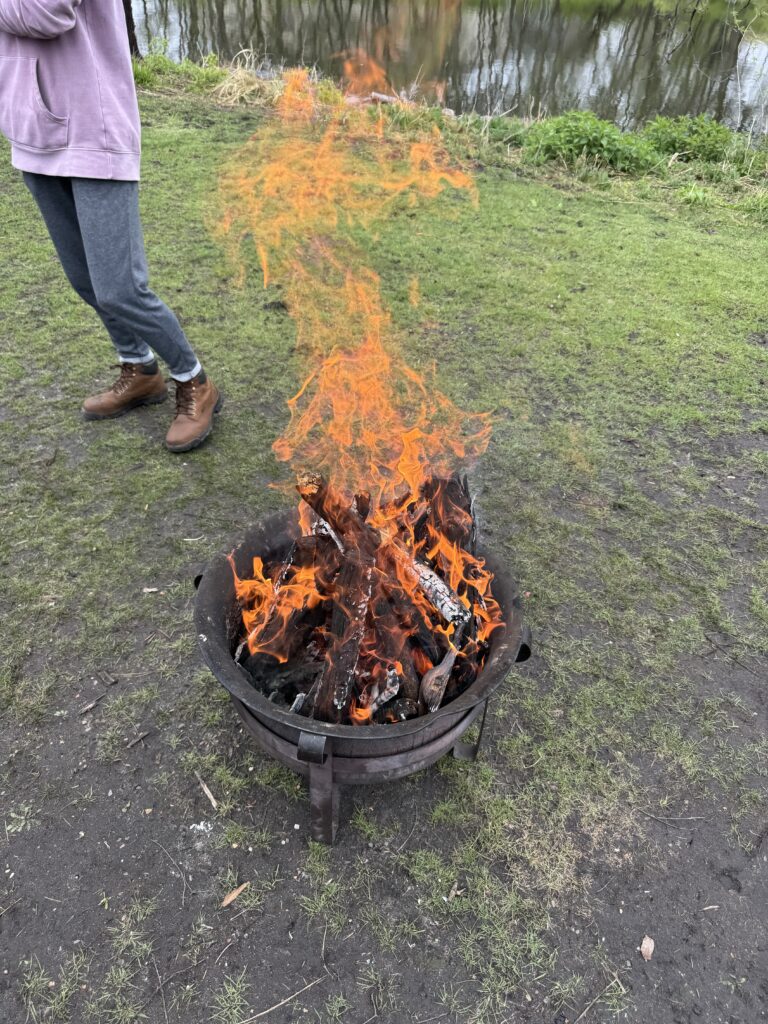
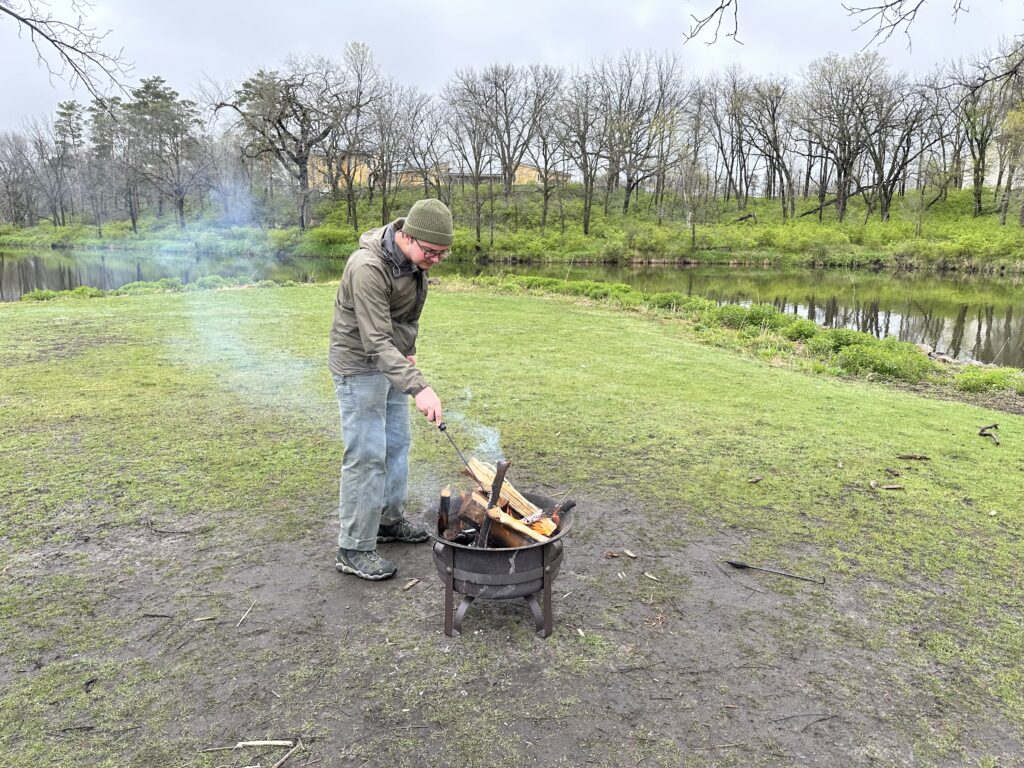
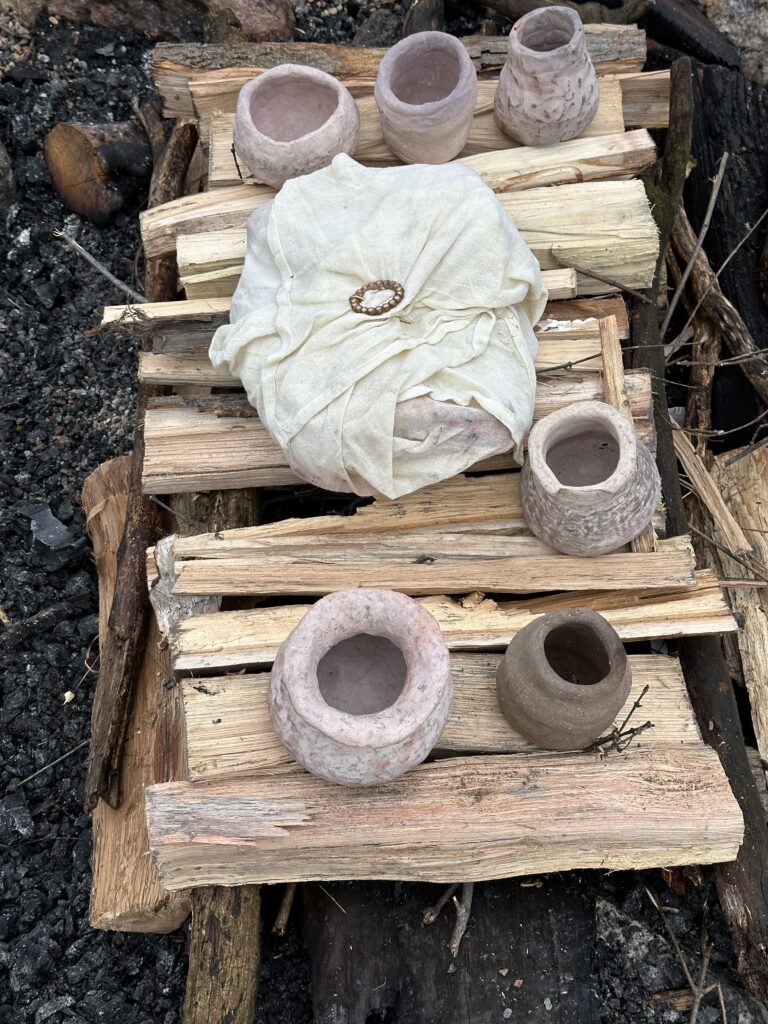
Groups C and D, with the members Albert Bosler, Caroline Gans, Evan Orjala, Margaret de Fer, Nicholas Spezia-Shwiff, and Alex Wilson, did the majority of the work in constructing, lighting, and maintaining the cremation pyre. The members of this group began by preparing our cremation imitation, which we quickly deemed “Coachella Baby.” This lamb shoulder was wrapped in marigold-dyed cloth from our dyeing lab, which was fastened by a brooch forged by a lab group from an earlier iteration of this course (Week Four of Fall 2021). We built an initial platform of dry wood suspended off the ground, and placed our imitation on the future pyre. After this, we heated our pots in the above-ground fire pits with Groups A, B, E, and F to around 230 degrees celsius before removing them and placing them on the pyre. From here, we had to move quickly to build up the pile, creating a teepee fire to protect our ritual items from the wind and engulf them in flames. We struggled to light the fire due to the elements, but with some additional fire starter we got it blazing within a few minutes. We stood around and watched as the fire caught, lighting the beams of wood underneath our pots and the funerary material. After a few minutes, the pebbles within about eight feet of the pyre had been dried from the rain, and the fire was hot enough to warm from nearly ten feet away. After about 45 minutes, the teepee collapsed on itself, but remained contained within the general area of the fire pit due to some tactful maneuvering by Dr. Austin Mason and Evan Orjala. We watched as the wood reduced to ash, our pots becoming more clearly visible, transformed by the heat and general process. After this, all of the groups moved their pots to the outer ring of the funeral pyre to cool them slowly, reducing potential for reverse thermal shock.
Process of construction the level platform of the pyre:

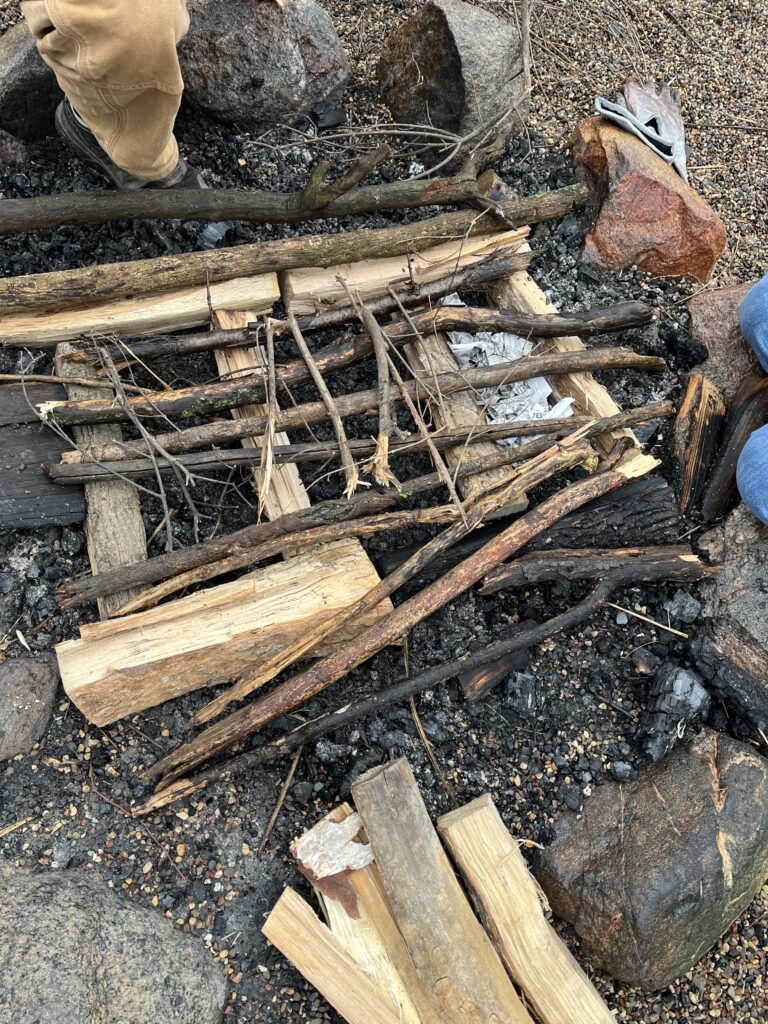
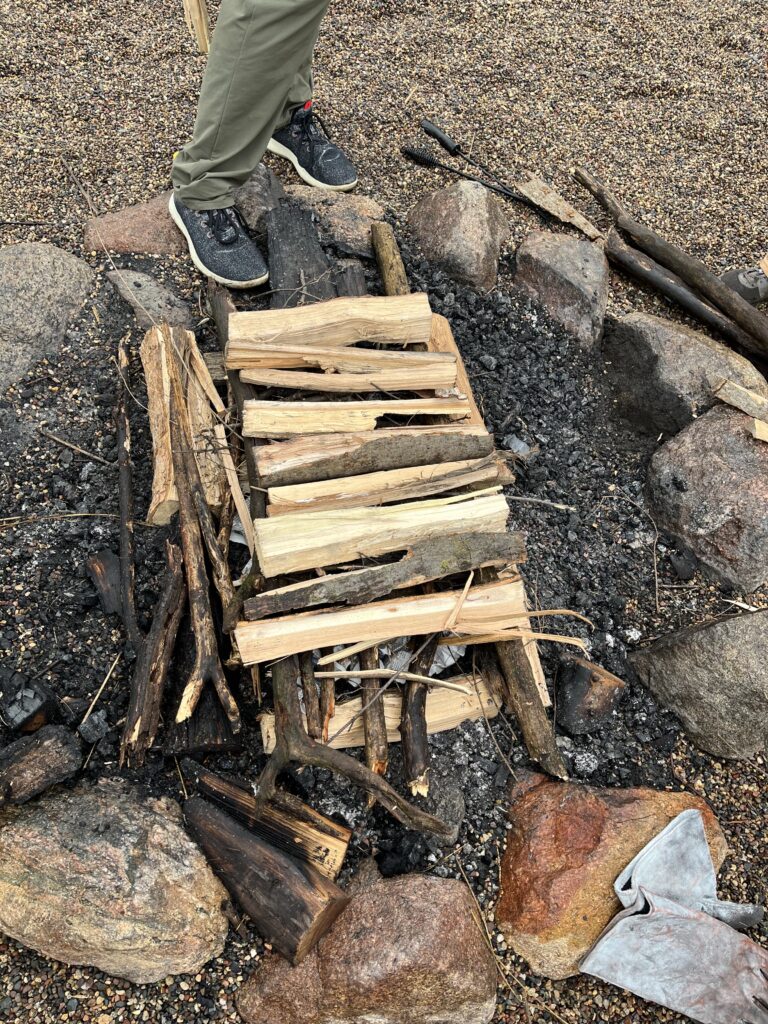
Data and Analysis
Fig. 1 depicts a 35 minute time spread appearing to begin at a point recent to the beginning of the individual fire-pits. Notably, everyone started recording their data at different points; however, one similarity is that everyone began recording their pot temperatures before 100˚C. Additionally, both Gisele’s and Elek’s pot temperature’s dipped at 25 minutes in a manner opposed to Max and Scott’s. After about 30 minutes, all four pot temperatures even out until the 45 minute mark. From then on, the two group’s data begins to diverge again, ending with approximately 206˚C for Elek and Gisele and 115˚C for Max and Scott. Please note that we did have to average the data collected for Max’s and Scott’s pot temperatures at certain points due to differences in time recording. Another important element to consider is the composition of the pots. Gisele’s pot was made of Arb clay and Elek’s was store-bought clay; considering this in our analysis, we can see that at 35 minutes Elek’s pot is at a higher temperature point. Otherwise their temperature trajectories are approximately the same. Comparatively, Max’s pot was the temper mixture of non-arb clay and Scott’s pot was arb clay; we can see that Scott’s pot temperature was consistently lower than Max’s until the 45 minute mark in which both pot’s temperatures converged (in terms of their averages). Another comparison can be made between Scott’s and Gisele’s arb clay pots as they both peaked around 40-45 minutes and began to decrease for approximately five minutes after.
Figure 2 – Pottery in Funeral Pyre
| Time (Hours) | Temperature˚C (Albert Pot) | Temperature˚C (Caroline Pot) | Observations (Albert Pot) | Observations (Caroline Pot) |
|---|---|---|---|---|
| 2:35 PM | N/A | 160˚C | N/A | N/A |
| 2:38 PM | 130˚C | N/A | The pot was in Group A/B’s pit at this time. Albert’s pot was occasionally being rotated, though with no consistency. | N/A |
| 2:44 PM | 150˚C | N/A | N/A | N/A |
| 2:45 PM | N/A | 195˚C | N/A | looks like a “golden smore” |
| 2:52 PM | 173˚C | N/A | N/A | N/A |
| 2:58 PM | 192˚C | 230˚C | Fire taken out of pit and placed on the pyre (soon to be lit) | taking pot out of fire pit now, to be transferred to pyre |
| 3:02 PM | N/A | 76˚C | N/A | pots cooled dramatically in the time they were out of the fire |
| 3:05 PM | 63˚C | N/A | Rapid cooling occurred while we were setting up the teepee around the pyre | N/A |
| 3:08 PM | N/A | N/A | Pyre was lit | Pyre was lit |
| 3:12 PM | 33˚C | N/A | Coolest point in temperature the pots reached, even though this was after the fire was lit at sometime around 3:06-3:10pm | N/A |
| 3:14 PM | N/A | 29˚C | N/A | N/A |
| 3:25 PM | 518˚C | N/A | N/A | N/A |
| 3:30 PM | N/A | N/A | N/A | fire is raging and about 500˚ C – pretty scary actually |
| 3:31 PM | Hi (used the wrong temperature recorder) | N/A | If I had to guess, the temperature here would be somewhere in the 600 degree range, though unfortunately the temperature recording error on my part means that this is unknown | N/A |
| 3:35 PM | N/A | 719˚C | N/A | my pot is completely black |
| 3:37 PM | 750˚C | N/A | Peak temperature of the pots that I recorded. Note the gap in time between 3:37p and 3:55p, during which time the fire very easily could have grown to above 800 degrees, as was our goal | N/A |
| 3:40 PM | N/A | 811˚C | N/A | potential spalding, but largely intact |
| 3:47 PM | N/A | 760˚C | N/A | N/A |
| 3:55 PM | 694˚C | N/A | N/A | N/A |
| 4:11 PM | 641˚C | N/A | N/A | N/A |
| 4:21 PM | 621˚C | N/A | The fire is mostly dead at this time, though the pot still retains a lot of heat | N/A |
| 4:24 PM | N/A | 621˚C | N/A | survived! but looking a bit worse for wear |
Fig. 2 combines qualitative and quantitative observations of the large funeral pyre with regard to the pots being fired. We chose this manner of display because most temperature data points were recorded at non-standardized time intervals and, while graphing could be interesting, we thought there was value in explicitly showing the different time-points in which individuals found interesting enough to record data at. To begin, there was one point in which temperature data was recorded for both Albert’s and Caroline’s pot (as highlighted above). At 2:58pm Albert’s pot is at 192˚C but Caroline’s was at 230˚C. These are the points in which their pots were taken out of their respective small fire pits to be put in the larger fire. Notably, as Albert’s pot was below 230˚C, his pot may not have been dry enough to be fired at this point. Both pots then cooled down to sub 35˚C during the intermediate time before the pyre was lit. Within the next approximately twenty minutes, both pots temperatures increased to over 500˚C alongside the overall funeral pyre temperature. At 3:37pm, approximately 29 minutes after the pyre was lit, Albert’s pot hit its maximum temperature point of 750˚C and Caroline’s pot reached a peak of 810˚C three minutes later. This temperature difference could be attributed to either the disparity of initial temperatures, spatial positioning within the funeral pyre, or a failure to capture data at the actual highest temperature point.
Fig. 3 depicts the changes in clay pot weight between the first creation day and three-weeks after creation day as well as the difference between before and after firing. These data points are then divided by clay pot composition with Albert’s pot representing the highest gravel composition of 19g, Evan’s representing a middle ground between chaff and gravel, and Hope’s displaying the highest chaff of 6g; Gisele’s bar shows the Arb clay. We chose to represent this data based on weight change rather than specific weight at each assigned day point because the variable of everyone’s initial pot weight could not be controlled. Note that both semi-equal chaff to gravel groups struggled to get data as group D did not have any of their post-firing weight and group C appeared to have scale issues on the first day. Therefore, Evan’s post firing change in weight could not be included. I instead chose to supplement this secondary data point with Emmett’s After Firing-Three Weeks ACD data as his pot was similar in size to Evans.
Both the Arb Clay and the Medium level temper group’s respective weight changes are similar. This may be because the actual level of chaff and gravel are not much different. In contrast, there is a clear distinction between Hope’s high initial weight loss v. low post firing loss and Albert’s low initial weight loss v. high post firing loss.
Further considering Gisele’s and Elek’s pots with respect to the temperature of the fire pit, the semi-linear trajectory is apparent. For the most part, as fire pit temperatures increased, so did pot temperatures. That being said, Elek’s pot consisted of the medium chaff to gravel ratio whereas Gisele’s pot was made of Arb clay. Gisele’s pot has a less irregular temperature trajectory than Elek’s, as especially notably at 532.6˚C and 422.6˚C. Such difference could be attributed to their pot’s respective compositions or just data acquisition differences. Before 330˚C, both pots were approximately equal in temperature but then quickly became varied. Additionally, we can see that Hope’s pot temperature, although missing some fire pit temperature values, was a generally linear decrease from the maximum of 852.8˚C; note some irregularity towards the end, likely with the addition of more kindling or something of that sort, that allowed Hope’s pot temperature to increase from 364˚C to 387˚C.
Conclusion
Although the lab manual did include instructions describing how to record data, this appeared to have been a more difficult task in practice as the actual standardization between the data of each group was hard to amalgamate into a cohesive narrative. Additionally, although the clay pot readings were relatively easy to acquire, it was nearly impossible to acquire both qualitative and quantitative iterative descriptions of the lamb shoulder for it was completely hidden and the thermocouple did indeed melt. For future labs, we propose increased communication between each group’s data recorder such that people agree when to begin timers etc.
Some pottery spalled and burst into sherds, but the vast majority stayed largely intact, especially those made with more temper or clay from the arboretum. Initially there was a lot of collective anxiety surrounding the potential loss of one’s own pottery creation, a sentiment likely shared with the peoples of the past. That being said, as time progressed throughout the lab, students became less worried as not many pots appeared to be breaking. As previously mentioned, those working on the preparation of the lamb shoulder decided on the name “Coachella Baby” and subsequently became emotionally attached. This led to more traditional rituals being invoked for experiential purposes such as the playing of “Taps” and moments of silence for the lamb shoulder.

With respect to the more theoretical, the readings for our classes in preparation for this lab emphasized ideas of transformation with regard to the visible and invisible through a pyre process. The experience of the color shifts in the pottery firing process is an example of a visible color mutation (see Caroline’s note at 3:35pm); however, to actually make this external observation, one has to poke and sift through ashes and embers of similar colors, making the transformation feel akin to more of an internal process. Another prominent experiential element of the lab was the sensation of heat, and its relationship with control, as experienced by those turning the pottery and by those standing around the pyre. We were able to use a multitude of instruments to tend the fire including a poker stick, fire-proof gloves, other pieces of wood, and our hands. However, this brings into question ideas of how past societies viewed fire and what sort of tools they used to tame it. Moreover, because the pit and its contents were so hot even on Friday (the day after the lab), the idea of prolonged heat and its relationship with transformation can again be problematized.


Overall this lab was a challenge, complicated by unfavorable weather conditions and wet fire-building materials. This resulted in a shorter pyre which burned for considerably less time than expected. Although we did not perform the final step in the cremation process, in which one is to place the ashes and artifacts left from the cremation within an urn as to finalize the “corporeal interaction of the living and the dead,” such sentiments of transformation and interpersonal exchange through the end of a life were present within each of our minds (Williams). Moreover, each and every student present at the lab was able to experience many of the components that make up the “multi-sensuous experience” of an Anglo-Saxon cremation (Williams). The trek to Mai Fête also reinforces the idea of a cremation experience quite a distance away from any burial event (Lucy). The idea of “person-time” as discussed earlier this term can yet again be applied to this lab and dually connected to past people’s cremation processes, especially if considering pottery firing as an included element.

– Beowulf
Sources
Lucy, Sam. “Cremation Burial Ritual.” In The Anglo-Saxon Way of Death : Burial Rites in Early England, 104-123. Stroud: Sutton, 2000.
Williams, Howard. “At the Funeral.” In Signals of Belief in Early England, 67-82. United States: Oxbow Books, 2010.

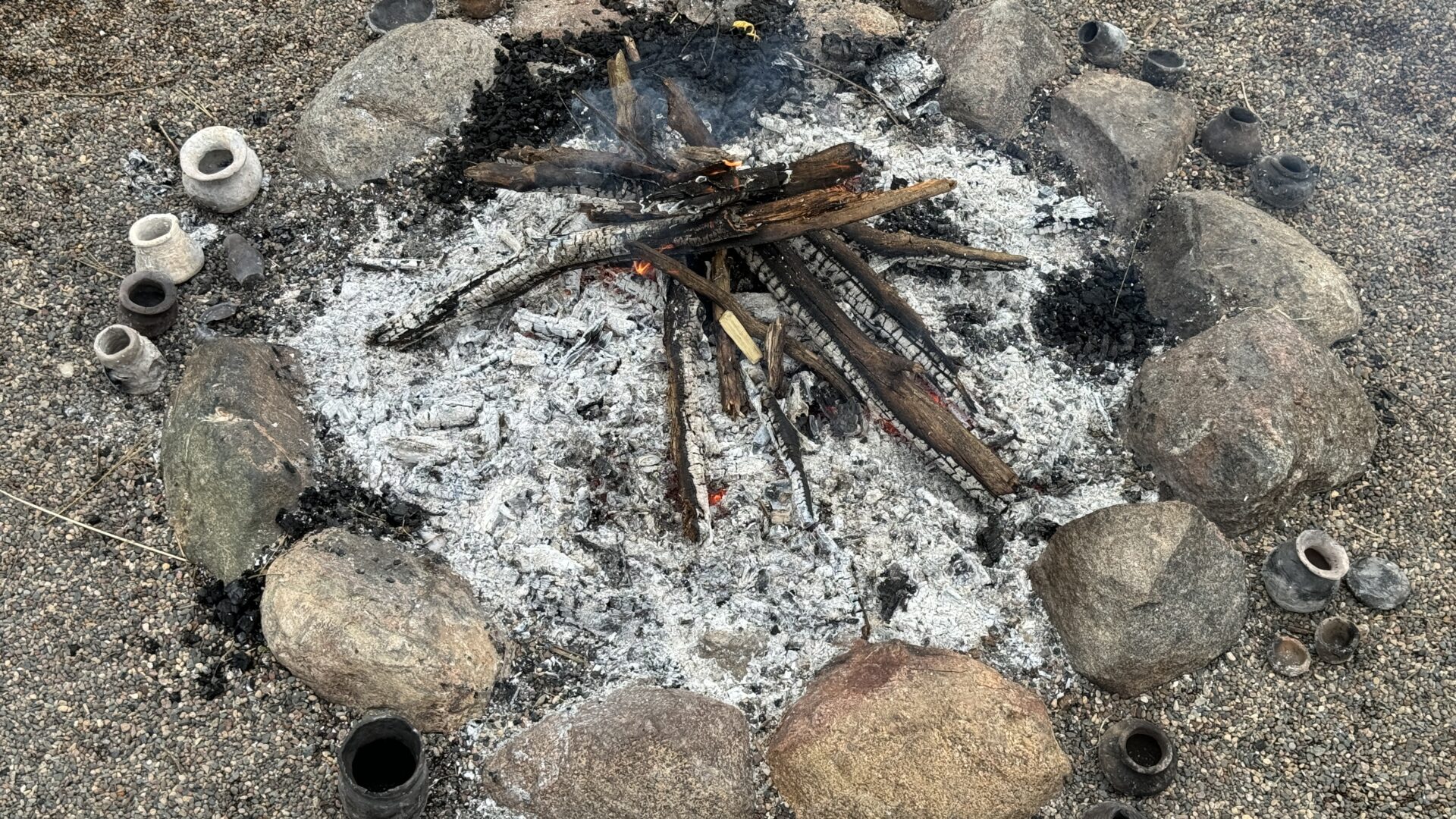
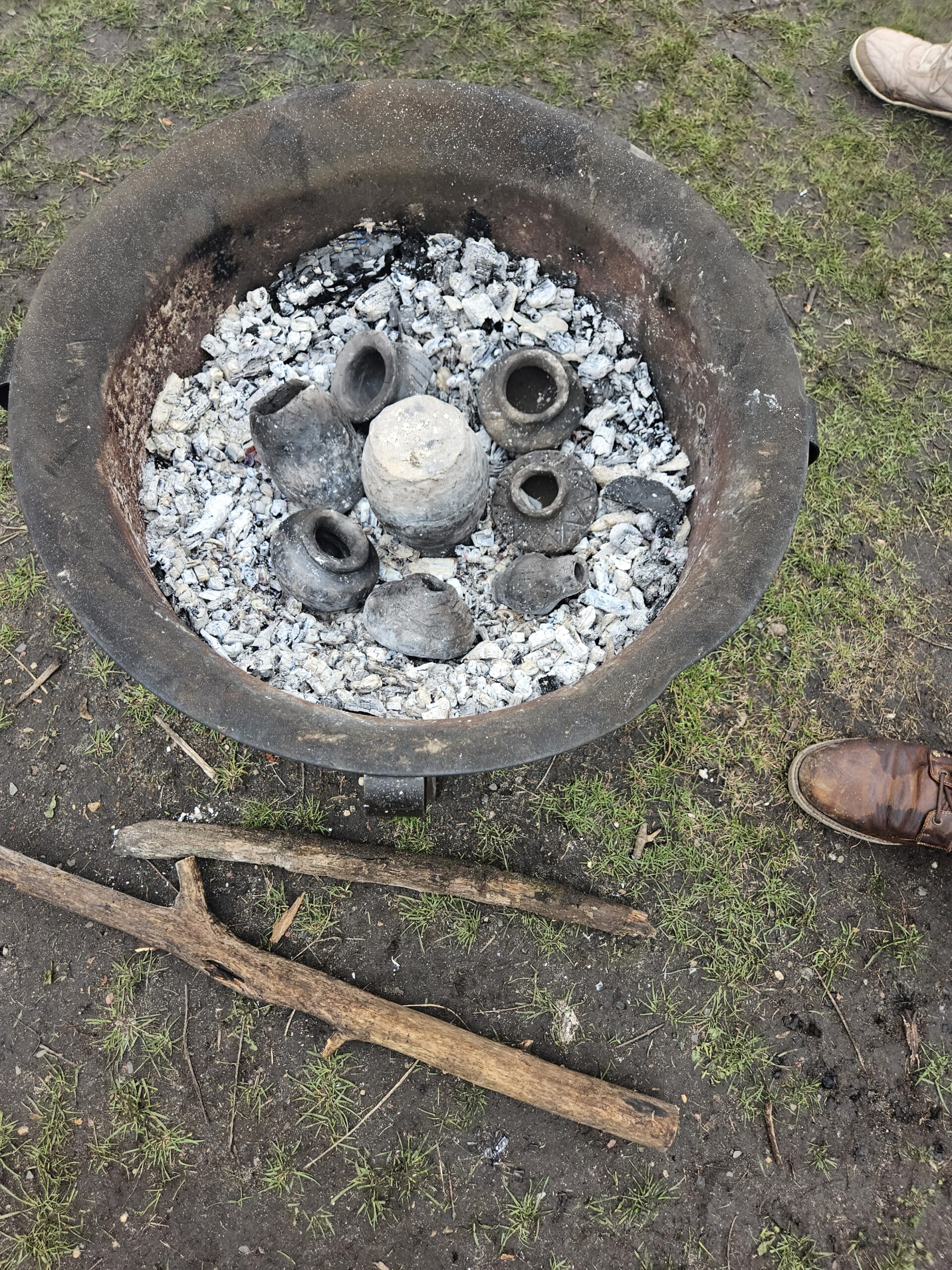

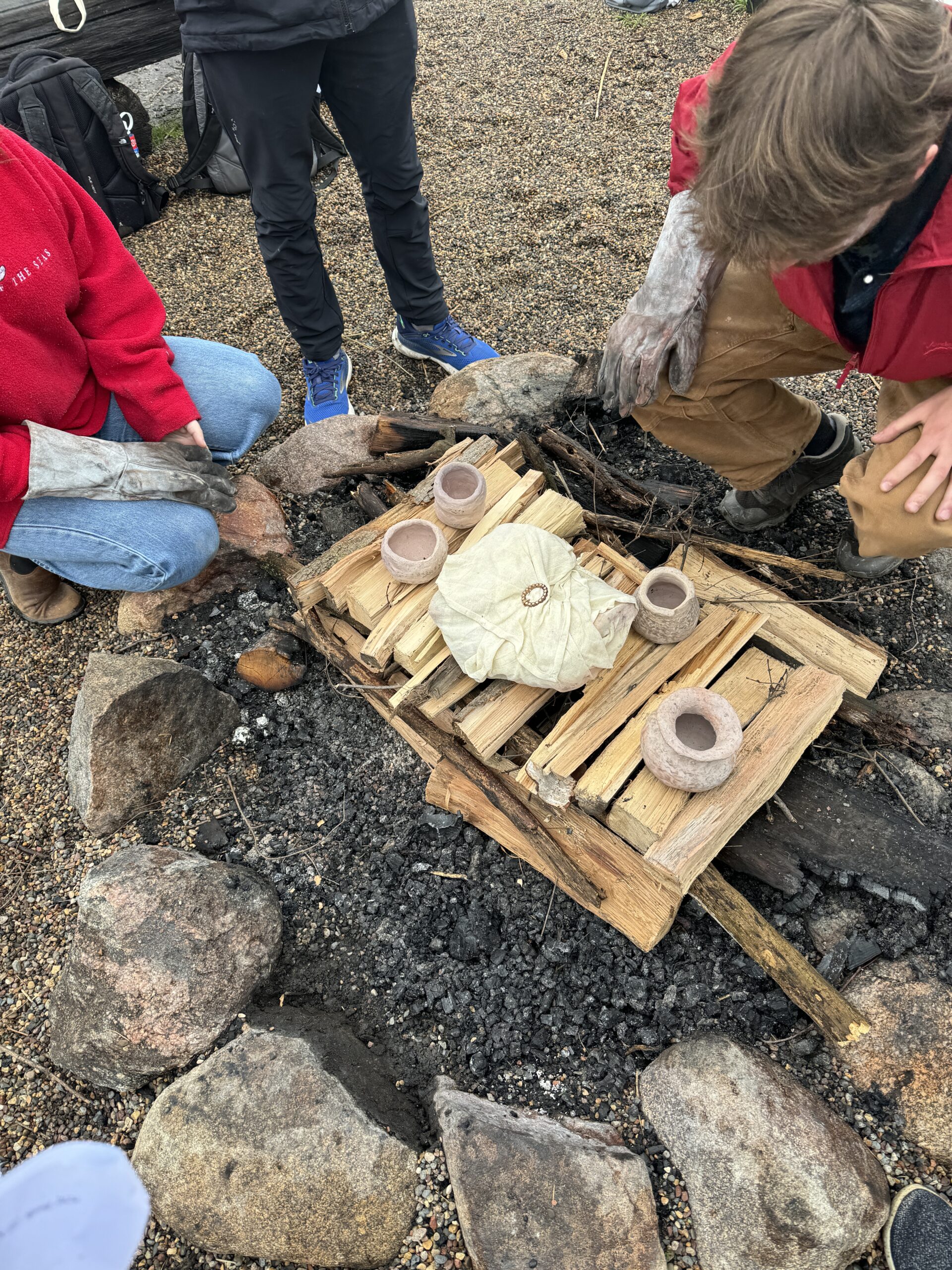
0 thoughts on “Lab Summary Week 6: Cremation & Pottery Firing”